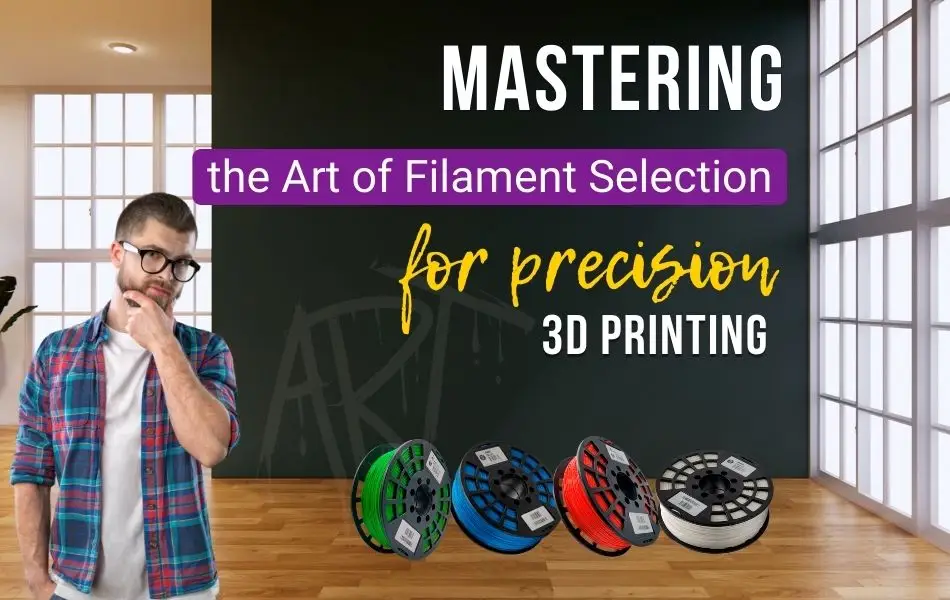Diving into the realm of 3D printing unveils a world of creativity and innovation, where the choice of filament becomes the cornerstone of bringing intricate designs to life. This guide embarks on a journey to demystify the complexities of filament selection, ensuring your detailed 3D printing projects take shape and stand out with unmatched precision and quality.

What is 3D Printing Filament?
At the heart of every 3D print lies the filament – a thread of material wound on a spool, ready to be melted and reshaped by the 3D printer. This seemingly simple component is pivotal in transforming digital blueprints into tangible objects. From the widely acclaimed PLA (Polylactic Acid) to the sturdy ABS (Acrylonitrile Butadiene Styrene), each filament type offers unique properties tailored for specific applications in 3D printing.
Why Is Filament Choice Crucial for Detailed 3D Printing?
Selecting the right filament is akin to choosing the right brush for a masterpiece painting. The intricacy of your print, its durability, and its finish all hinge on this crucial choice.
With the evolution of 3D printing technology, achieving high-resolution prints demands a 3D printing filament that matches the complexity of your design and the functional requirements of the finished product.
Types of Filaments for Detailed 3D Printing

Exploring the vast landscape of 3D printing filaments reveals a variety of materials each designed to meet different needs. Here’s a closer look at some of the key players:
| PLA (Polylactic Acid) | Biodegradable, easy to print, low warping | |
| ABS Filament | ABS (Acrylonitrile Butadiene Styrene) | High strength, good durability, slightly flexible |
| PETG Filament | PETG (Polyethylene Terephthalate Glycol) | Good durability, chemical resistant, low shrinkage |
| ASA Filament | ASA (Acrylonitrile Styrene Acrylate) | UV resistant, high durability, great for outdoor use |
| TPU Filament | TPU (Thermoplastic Polyurethane) | Flexible, abrasion-resistant, good elasticity |
| Nylon Filament | Nylon | High strength, flexibility, wear resistance |
| Resin | Photopolymer Resin | High detail, smooth finishes, for SLA/DLP printing |
How to Determine the Best Filament for Your Project?
Choosing the best filament requires a deep understanding of your project’s needs. Consider the level of detail required, the mechanical properties like strength and flexibility, and the compatibility with your printer. This decision-making process ensures that the chosen filament brings your design to life and meets the final product’s functional demands.
Comparing Filament Properties for Detailed Printing
The quest for precision in 3D printing necessitates a comparative analysis of filament properties. Factors such as resolution, strength, flexibility, and temperature resistance vary significantly across different materials, impacting the quality and applicability of your prints.
The Role of Filament Diameter in Detailed 3D Printing

1.75mm vs. 3.00mm Filaments
The diameter of the filament plays a critical role in the resolution of your prints. While 1.75mm filaments offer finer detail and faster heating, 3.00mm filaments provide greater structural strength. Choosing the right diameter is pivotal in achieving the desired balance between detail and durability.
Optimizing Printer Settings for Detailed Prints with Different Filaments
Adjusting your printer settings to match the filament type is essential for detailed printing. This includes fine-tuning the temperature, print speed, and layer height to optimize the quality of your prints. Each filament demands a unique set of parameters to unlock its full potential.
The Importance of Filament Storage for Maintaining Quality
Proper filament storage is crucial in preserving its quality. Moisture, dust, and UV light can degrade the filament, affecting its performance. Implementing good storage practices ensures consistent results in your detailed printing projects.
Troubleshooting Common Issues with Filament for Detailed Prints
These common issues can mar the precision of your prints. Understanding their causes and solutions is critical to maintaining the integrity of your detailed projects.
Advanced Filaments for Ultra-Detailed 3D Printing

The frontier of detailed 3D printing is continually expanding with the introduction of advanced and specialty filaments. These materials, including composite and conductive filaments, open new avenues for ultra-detailed prints, pushing the boundaries of what can be achieved.
Step-by-Step Guide to Choosing the Right Filament
Selecting the right filament involves a step-by-step approach, from defining your project requirements to testing filament samples. This systematic process ensures a match that meets and exceeds your expectations.
Case Studies: Successful Detailed Prints with Various Filaments
- Utilizing PLA for intricate art pieces.
- Leveraging ABS for durable mechanical parts.
- Exploring the flexibility of TPU in wearable designs.
These examples illustrate the versatility of filaments in bringing diverse projects to fruition, each with its unique challenges and triumphs.
Future Trends in Filament Development for Detailed 3D Printing
The evolution of filament technology holds promising prospects for detailed 3D printing. Emerging materials and enhancements in filament composition are set to redefine the limits of precision and functionality, paving the way for groundbreaking 3D printing applications.
Conclusion
The journey through the intricacies of filament selection for detailed 3D printing underscores the pivotal role of material choice in the success of your projects. By understanding the properties, applications, and nuances of various filaments, you can unlock the full potential of your designs, ensuring each print stands as a testament to precision and quality. As we look to the future, the continuous innovation in filament technology promises to elevate detailed 3D printing to unprecedented heights, offering endless possibilities for creators and innovators alike.
